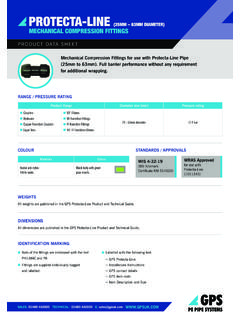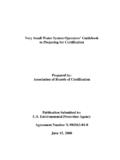Transcription of Polyethylene Pipe Industry UK BEST PRACTICE
1 Plastic pipe Handling UK Industry - best PRACTICE 1 of 12 Industry Forum version 11 Polyethylene pipe Industry UK best PRACTICE Recommended Guidelines for the Safe Delivery and Unloading of Polyethylene Pipes This guide is intended to provide a risk-based framework to assist with the safe planning, delivery and unloading of Polyethylene pipes. By incorporating these best PRACTICE precautions into supporting local/site procedures; suppliers, hauliers and customers will be able to focus on the site-specific risks and their control in the prevention of incidents and injuries to employees, contractors and members of the public. To ensure a safe and trouble free delivery your compliance with these guidelines is requested. Deliveries could be at risk if this Industry -approved PRACTICE is not followed.
2 Issue 11 1st June 2013 Plastic pipe Handling UK Industry - best PRACTICE 2 of 12 Industry Forum version 11 Contents 1. Foreword by HSE 2. Definitions 3. Summary 4. Risk Assessment 5. Order placement 6. Receiving and unloading pipe deliveries 7. Further guidance 8. Contributors Appendix 1. Pro Forma Health and Safety checklist Appendix 2. Driver Customer Hazard Spotting Report Plastic pipe Handling UK Industry - best PRACTICE 3 of 12 Industry Forum version 11 1. Foreword It is always a pleasure to welcome an example of good PRACTICE in developing safe systems of work. It is a particular pleasure to be able to welcome an example where people from different sectors of Industry have come together to work out solutions to a common problem in this case how to be sure that plastic piping systems may be delivered and unloaded safely to a variety of different sites.
3 One of the greatest obstacles to managing safe deliveries is lack of communication and cooperation between suppliers and customers. So when I first heard that the Plastic Pipes Industry Forum had convened the whole supply chain to get together to tackle this area of risk, I was delighted and I wished them success in their aim of producing a set of guidelines that all the industries represented in the supply chain would feel able to sign up to. Now the results of their hard work are here, expressed in this document as guidelines that are sensible and in proportion to the risk, clear and easy to follow, and comprehensive to the matter in hand. I think this is an excellent example of what can be achieved when all parties get together to sort out an issue. I commend these guidelines and this cooperative method of developing them to everyone who receives deliveries of plastic pipes and fittings.
4 Marcia Davies HSE Head of Injuries Reduction Programme December 2008 Plastic pipe Handling UK Industry - best PRACTICE 4 of 12 Industry Forum version 11 2. Definitions For the purpose of this document, the following role definitions apply. 1) Customer an individual or company placing an order request for the supply of Polyethylene pipes to a defined location of their request. 2) Supplier the company receiving an order to supply Polyethylene pipes to the specification and quantity of the customer s request. 3) Haulier the company or organisation contracted by the supplier to under-take the delivery of the Polyethylene pipes to the specified location, as instructed by the supplier. 4) Driver the employee of the haulier who will be responsible for the safe delivery of the Polyethylene pipes.
5 Where a hiab is requested, the driver is also responsible for the safe off-loading of the Polyethylene pipes. 5) Lifting Assistant this is a competent person who can assist by holding a guide rope to stabilise pipes during the off-loading process. Other duties of the lifting assistant may include footing a ladder and carrying out traffic management duties. 6) Site Responsible Person this individual has the overall responsibility for Health and Safety on the site. 7) Pro forma Health and Safety Checklist is to be completed in conjunction with the end user. This ensures that the delivery process has been carefully thought through, reducing health and safety risks and enhancing the overall delivery performance. Driver Lifting Assistant Driver Lifting Assistant Ladder being footed during slinging operation pipe being guided to the floor by lifting assistant.
6 Note: Driver has remote control for crane operation. Guide ropes may be required on coils and pipe lengths. Plastic pipe Handling UK Industry - best PRACTICE 5 of 12 Industry Forum version 11 3. Summary There is a common misconception within the Industry that Polyethylene pipes are lightweight and thus do not require health and safety controls in order to avoid personal injury. This guide highlights the precautions that should be followed to control plastic ( Polyethylene ) pipes being delivered, off-loaded and stored safely at customer s sites. The underlying theme is that Polyethylene pipe products should be treated with a similar level of caution and respect as afforded to other similar heavy products. This Industry working-group best PRACTICE will provide tangible benefits across the complete supply chain.
7 The benefits include; enhanced safety levels throughout the delivery and unloading process and an increase in delivery and unloading efficiency. All parties engaged in the delivery and unloading process have responsibilities under the Health & Safety at Work Act 1974 & associated legislation. Listed at the end of this document are the General Compliance and Safety Requirements that apply to this process. A risk-based matrix has been developed below to describe the general dynamic nature of delivery and offloading at customer s sites and the recommended control measures. Risk Situation Control Measures Low Delivering and offloading to a customer s known main material handling location. Localised risk assessments, safe systems of work and suitable training provisions.
8 Medium Delivering and offloading to customer s local operational depots/stores. Localised risk assessments, safe systems of work and suitable training provisions. For all new depots and stores customer is to complete a Pro Forma Checklist . A copy of this is to be forwarded to the supplier. The delivery driver is to complete a Customer Hazard Spotting Report . High Delivering and offloading to customer s transient work sites, which could be within the public highway. Localised risk assessments, safe systems of work, inductions and suitable training provisions. Prior to ordering PE pipes the customer is to complete a Pro Forma H&S Checklist (see page 12). A copy of this is to be forwarded to the supplier. Note; upon request a representative of the supplier can assist by carrying out a site inspection.
9 Plastic pipe Handling UK Industry - best PRACTICE 6 of 12 Industry Forum version 11 Any party involved in the unloading activity has the right to stop the process at anytime if they believe there is a risk to safety. Such intervention shall be immediately reported to the named Site Responsible Person and to the haulier. It will be the responsibility of the haulier to report to the supplier. PE pipe Delivery and Offloading 4. Risk Assessment Depot, site & haulier risk assessments should be documented prior to accepting Polyethylene pipe deliveries. The company receiving the pipe delivery are to consider: Access and egress to site Access to the trailer to remove load securing devices is this permitted? If it is not permitted then request that the load arrives with strops around the pipe coils and pipe lengths SWL and fitness for purpose of slings used in the lifting process Traffic management one way system or road closure to facilitate suitable safe operational space Pedestrian management Overhead obstructions and height constraints Safe zone for off-loading The location for unloading/storage shall be on firm, level ground, free from damaging material Suitability of the off-loading method to the task (if in doubt request a hiab) Ensuring that the off-loading area is of hard standing (vehicle) and that there is adequate room for out riggers to be fully extended without obstructing traffic flow (on-board crane deliveries)
10 Typically 6-metre span PPE requirements Site inductions, to include sharing of risk assessments Named Site Responsible Person and trained Lifting Assistant (CPCS or equivalent, see definitions on page 4) and ensuring that there is someone present to witness the off-loading process and sign for the pipe delivery Roadside deliveries must be carefully planned to ensure that there is an exclusion zone around the lorry. Traffic management is a major consideration, as pipe must not be unloaded with traffic passing in close proximity to the trailer and the crane operator Safe storage provisions Emergency procedures Fire assembly point First aid representatives Adverse weather conditions Lighting provision 5. Order Placement When placing orders for Polyethylene pipe products, the following delivery information should be communicated to the supplier (see the pro forma health and safety checklist for more details).










